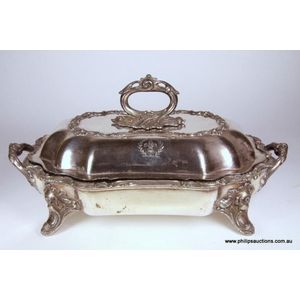Victorian Marble Top Chiffonier with Mirrored Back
You must be a subscriber, and be logged in to view price and dealer details.
Subscribe Now to view actual auction price for this item
When you subscribe, you have the option of setting the currency in which to display prices to $Au, $US, $NZ or Stg.
- Mahogany - Mahogany is a dense, close grained red-coloured timber from the West Indies and Central America. It was first imported into Europe in the the early 18th century and its use continued through the 19th century. It was popular for furniture making because of its strength, the wide boards available, the distinctive grain on some boards, termed flame mahogany and the rich warm colour of the timber when it was polished.. The "flame" was produced where a limb grew out from the trunk of the tree, and this timber was usually sliced into veneers for feature panels on doors, backs and cornices.
Some terms used to describe mahogany relate to the country from which it originally came, such as "Cuban" mahogany, "Honduras" mahogany etc. However unless the wood has been tested the names assigned are more a selling feature, rather than a true indication of the timber's origin. - Victorian Period - The Victorian period of furniture and decorative arts design covers the reign of Queen Victoria from 1837 to 1901. There was not one dominant style of furniture in the Victorian period. Designers used and modified many historical styles such as Gothic, Tudor, Elizabethan, English Rococo, Neoclassical and others, although use of some styles, such as English Rococo and Gothic tended to dominate the furniture manufacture of the period.
The Victorian period was preceded by the Regency and William IV periods, and followed by the Edwardian period, named for Edward VII (1841 ? 1910) who was King of the United Kingdom and the British Dominions and Emperor of India for the brief period from 1901 until his death in 1910. - Plinth - The square or rectangular base of a piece of cabinet furniture, often ornamented with moulding. The plinth may be separate, as in some wardrobes or presses, and act as the support for the carcase. In a false plinth, the moulded boards may be attached directly to the piece. Furniture with a plinth base usually does not have separate feet. The term derives from architecture where it denotes the base of a column or statue.
- Corbel - An architectural term for a support for a projecting bracket, ostensibly supporting a beam or horizontal feature, but used in bookcases, sideboards and chests as a decorative element. Corbels are often carved with acanthus or other scrolling decoration.
- Column - An architectural feature sometimes used for decorative effect and sometimes as part of the supporting construction. Columns should generally taper slightly towards the top. They may be plain or decorated with carving, fluting or reeding. Columns may be fully rounded or, more commonly, half-rounded and attached with glue, screws or pins to the outer stiles of doors, or the facing uprights on cabinets and bureaux.
This item has been included into following indexes:
-
chiffoniers (small sideboards), period or style
- mirror back 32
- Victorian 181
- chiffoniers (small sideboards), timber - mahogany 130
Visually similar items

A French parquetry jewellery case by Maison Alphonse Giroux et Cie. Paris, of serpentine commode shape with four wing hinged drawers beneath a hinged lid, the ebonized surfaces embellished with applied cut brass mounts and two oval miniature oil panels of

A French parquetry jewellery case by Maison Alphonse Giroux et Cie. Paris, of serpentine commode shape with four wing hinged drawers beneath a hinged lid, the ebonized surfaces embellished with applied cut brass mounts and two oval miniature oil panels of

A good large Japanese Meiji period bronze hibachi, octagonal form with decorative landscape panels, two open handles, raised on four mythical mask feet and raised on a conforming wood base. Good old patina. 55 cm x 49 cm x 35 cm

A Victorian Sheffield plate vegetable tureen, 19th century, a substantial shaped rectangular tureen well cast in the rococo revival manner, having a deep warming base, a fitted shallow dish and domed lid with a removable foliate form handle, bearing a fleu
